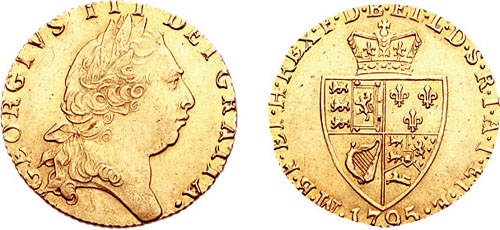
The British Guinea represents both a collectible coin as well as gold bullion asset, which makes it potentially twice as valuable, depending on the coin year, grade, condition and ownership. Gold Guineas represent an optional pursuit of precious metal investment which have the added flavor of numismatic appeal as well. So, rather than just focusing on a base gold investment alone, one can make their financial holding a bit of a hobby as well. That said, the rest of the finance world is well aware of the value of gold Guineas, and they are priced accordingly in various markets. However, occasionally one pops up in common private transactions, the most common of which tend to be estate sales and inheritances. And that’s when things get really interesting.
Historical Background
The British Guinea came about starting in 1663. The coin and distinct form were issued by British government mints for almost 151 years ending in 1814 (ironically right after the War of 1812 which probably sapped a good amount of the British sovereign gold to pay for its recent military activities across the pond). Each coin was measured and minted to include one fourth or a quarter of an ounce of pure gold. The name, however, had nothing to do with the British Isles. Instead, it was an identification of where much of the sovereign gold was being sourced from in West Africa.
Another unique historical aspect of the Guinea comes in the fact that it was the first gold coin the British government issued that was entirely manufactured or struck by mechanical means. The original price was suppose to stay at one English pound sterling, but that didn’t hold for very long. Differences in values between gold and silver quickly caused variations, bouncing from a low of 20 shillings to as much as 50 percent higher at 30 shillings over the long life of the Guinea series.
The beginning of the downfall for the gold Guinea came in the British government’s shift to a gold standard backing paper money. By this point, the Guinea had already become a bit of a collector coin versus a regularly circulated currency. Ironically, its name was still being used in the accounting arena as well as in professional circles such as medicine and law and horse-racing.
Various Forms of the British Guinea
When it comes to buying gold Guineas or selling them to liquidate and receive a return on an investment, it’s important to understand that the gold value plus the time and collectability of the coin will all influence its final value for sale.
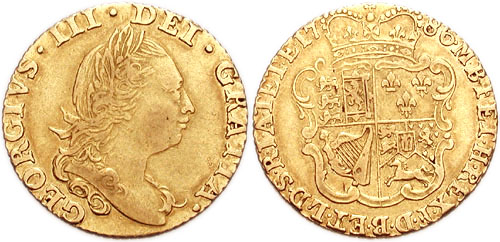
The Charles II Series
The first series of Guinea coins produce an obvious and distinct character with the profile of King Charles II on them. These coins ran from 1631 to 1700, with one side presenting an image of a wreathed Charles II, and the other side showing four shields representing the three countries of the United Kingdom as well as France.
The James II Series
By 1685, James II was now the primary title, and the Guinea coin had changed dramatically. Gone was the wreathed profile of Charles II and the four shields on the obverse side, only to be replaced with James II’s profile as well as an elephant and castle mark on some coins and others without it. These coins had a very short mint window, being replaced by 1688. It may have had something to do with the Glorious Revolution. James II did not lose his head as some rumors portrayed; instead, he died in exile after losing a battle to William of Orange.
The William & Mary Series
James the II was now out and the new monarchs, Prince William of Orange and his queen (James II’s daughter) Mary were now on the coin profile. The two appear side by side on one part of the coin, and the obverse side of the Guinea has a large shield emblem with four sections, each bearing the arms of England, Scotland, Ireland and France. This motif and coin series ran from 1689 to about 1694. Smallpox then took its toll on Mary, and William III was left to reign alone. Mary’s death triggered a modification to the gold Guinea that ran from 1695 to 1701 with only William’s face on the coins rather than both him and Mary.
The Queen Anne Series
Following William III’s reign, Queen Anne then took over and a respective gold coin was stamped and produced for her, running from 1702 until 1714. It was during this period and particularly in 1707 that the Guinea went through a major change noted on the coin’s design. With Great Britain actually formalized for the first time, consolidating Scotland and England, the British Guinea was modified accordingly. The four-country logos on the opposite side of the coin from the monarch’s profile changed and France was dropped. Instead, the shield emblem now represented England, and Scotland, and representations of Ireland and France became buried in minor symbology. These coins also included the highest content of gold produced yet in a Guinea, with a 0.9134 purity.
The George I Series
The coin reflecting King George I’s reign only lasted a short 13 years, running from 1714 to 1727. In this version the king’s profile once again takes up one side of the coin, and the obverse side of the Guinea has the country’s emblems on it. Interestingly, this run of gold Guineas included five different versions of the king’s profile or portrait during his tenure.
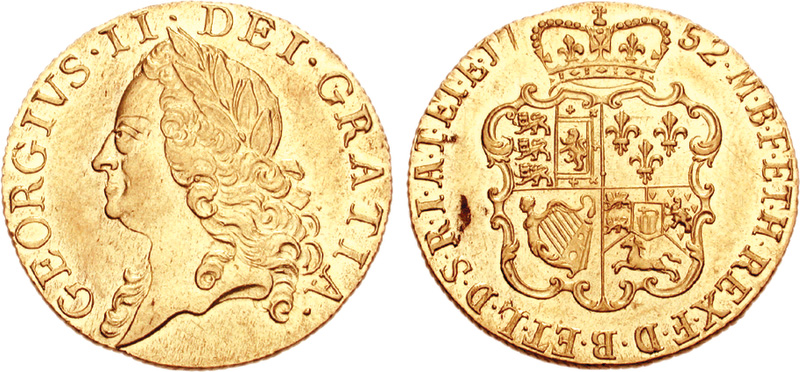
The George II Series
The next monarch to achieve coin reflection status triggered another significant change to the gold Guinea. King George II’s tenure ran for a lengthy 33 years, and his coins were available and minted for all but four years during that period. The purity level was generally about the same as earlier.
The George III Series
The next monarch being George III, his coin also retained the higher purity level of before, 0.9146, with the monarch’s portrait on one side and the shield emblem on the other reflecting the arms of England, Scotland, France and Ireland as well as newcomer, Hanover. It was during George III’s tenure that the spade-shaped shield emblem was introduced, triggering the nickname, the “spade guinea.” This phase was also a major destructor of the coinage past. It is estimated that at least 20 million gold Guinea coins worn down from earlier periods, mostly William and Anne’s reign, were slagged and remolded into new issue coins as part of the King George III series. It was by this time as well, near 1799 and 1800, that gold was in short supply. However, yet another half Guinea was issued in 1808, and by 1813 a slew of new gold coins had to be minted again. Why? Armies need to be paid when they march, and the Duke of Wellington was busy fighting a war against Napoleon with soldiers who were only going to march with coin in their pockets. Finally, 1816 arrived and the gold Guinea was finally put to rest, unceremoniously replaced by the British Pound and the new gold standard.
The 2013 Reissue
To commemorate the long history of the historical Guinea gold coin in all its phases, the British Royal Mint issued a new, 2013 two Pound coin recognizing 350 years since the creation of the first gold Guinea sovereign coin. This commemorative coin included a spade Guinea design on the emblem side, as well as famous quote from Stephen Kemble on the edge of the coin.
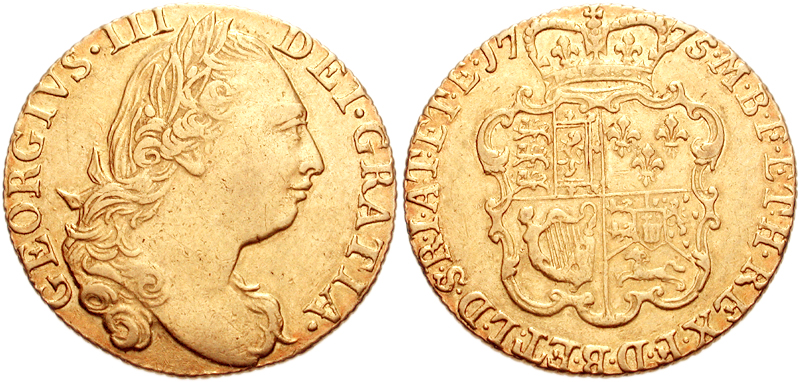
What to Expect for a Gold Guinea Today & How to Sell Gold Guinea Coins
The gold Guinea is not going to achieve or be on par with some of the major sovereign bullion coins today like the South African Krugerrand or the Canadian Maple Leaf, however, the gold British Guinea is no slouch either. It’s gold content includes a very specific value of 22 karat purity that embodies a hefty 8.3 grams of weight. Scoring at a perfect 25 percent of a Troy ounce today, a basic Guinea coin, without considering its collectability value, will easily be worth $683.88 NZ dollars ($472.5 USD). Those interested in selling should note that because gold British Guineas have a lot of variation, the size of the coin also comes in various price amounts as well. Half-Guineas, Third-Guineas and Quarter-Guineas were all minted with 22 karat gold, so the variation tends to be simply a fraction of a whole Guinea and its value versus a Troy ounce.
When selling a historical gold coin or a collection of old gold coins, British Guineas will need to be tested. While they are, technically, sovereign bullion coins, the last production finished some 204 years ago. They don’t have a current standard available anymore. That leaves a lot of room for potential fraud which, believe it or not, is on the rise in 2020. Some of the most amazing fakes involve intricate work to replicate older gold coins and in fact have turned out to be gold-plated bronze, copper or zinc fakes. Many are just hitting the market in recent years due to advances in technology that didn’t exist just 10 years ago. To insure that what is being sold is in fact an authentic gold coin, professional buyers will verify the year and series of the coin, its weight, its gold metal nature and chemical response. Private sellers should not be alarmed or offended by these procedures. There are a lot of fakes and attempts at fraud circulating in the private market online like eBay and similar, particularly with older coins like the Guinea and earlier. So, validating a purchase is standard procedure for any gold buyer dealership that knows its industry well.
Remember, the gold Guinea coin value offered is going to vary depending on whom a private seller is working with. A bullion gold buyer is going to focus on the gold content and weight of the coin and offer pricing consistent with the current spot price for gold as well as a discount for buying. They will not price in any numismatic value of the coin, regardless of which year or series the particular Guinea was part of. If one wants to achieve a sale for a coin that includes both its gold intrinsic value as well as coin collectability, then he or she should be working with a numismatic coin dealer instead. Their market will be far more aligned with the coin collectability side as well as the demand for such coins for historical and rarity value.
The above said, there has been a rise in the gold Guinea worth both for the gold content value alone as well as for the collectability of the gold coins UK rarities. Both aspects have seen significant demand price increases in the last few years, which bodes well for sellers of all types who are looking to liquidate the gold Guineas they have on hand.
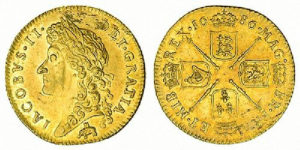
Extra Baggage from the Government
Many wonder if selling a gold Guinea is a smart idea when it comes to personal taxes. After all, in the high number of cases, people end up with these historical gold coins through estate sales or inheritance as mentioned earlier. So, receiving such a coin and then selling it logically seems like a 100 percent profit absent any shipping costs involved. Does New Zealand tax the private sales of British Guinea coins? Known as capital gains tax or goods and sales tax in the accounting world, New Zealand generally only applies a goods and services tax (GST) on coin transactions where the seller regularly sells those goods and services. So, for the private seller selling a windfall from an inheritance, the GST levy would probably not apply. However, if the private seller is a collector who traffics, buys and sells coins on a regular basis, then the GST could apply. The best way to know is the read the details directly from the New Zealand government or to consult with a tax adviser on the same.
How to Sell a Gold Guinea Safe & Reliably
If you find yourself in the opportune situation of receiving gold Guineas you wish to liquidate, or you wish to pare down an existing collection, GoldSmart can help. Our professional buying team provides a no-pressure, safe environment where we can objectively value your coins and provide you a fair offer based on the current gold market for repurchase, including historical sovereign coins. Many worry that while they know they can sell a gold coin easily, the party they deal with may try to pull a fast one. GoldSmart has never opted for these kinds of unscrupulous business practices. We maintain a high quality professional approach always. Our buyers are fully trained and will never pressure any potential seller into a sale he or she is not comfortable with. In fact, we’d rather educate a person on what they have in terms of coinage, gold value and history and build a relationship for the future than resort to a higher pressure tactic. So, if you have gold Guineas you wish to sell comfortably give us a call or email, and we can arrange an appointment that works best for you.